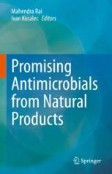Search
Search Results
-
A review of applications and limitations of using aquatic macroinvertebrate predators for biocontrol of the African malaria mosquito, Anopheles gambiae sensu lato
Macroinvertebrate predators such as backswimmers (Heteroptera: Notonectidae), dragonflies (Odonata: Aeshnidae), and predatory diving beetles...

-
Bacteriophage as Biocontrol Agents
Bacteriophages produce an antibacterial effect, but that does not make them the same thing as conventional chemical antibacterial agents...
-
Bacteriophage as Biocontrol Agents
Bacteriophages produce an antibacterial effect, but that does not make them the same thing as conventional chemical antibacterial agents...
-
Characterization of vB_VpaP_MGD2, a newly isolated bacteriophage with biocontrol potential against multidrug-resistant Vibrio parahaemolyticus
Vibrio parahaemolyticus is a major foodborne pathogen and is also pathogenic to shrimp. Due to the emergence of multidrug-resistant V. parahaemolyticus ...

-
Implications of increasing temperature stress for predatory biocontrol of vector mosquitoes
BackgroundPredators play a critical role in regulating larval mosquito prey populations in aquatic habitats. Understanding predator-prey responses to...

-
Isolation and characterization of a novel phage belonging to a new genus against Vibrio parahaemolyticus
BackgroundVibrio parahaemolyticus is a major foodborne pathogen that contaminates aquatic products and causes great economic losses to aquaculture....

-
Application of BI-EHEC and BI-EPEC bacteriophages to control enterohemorrhagic and enteropathogenic escherichia coli on various food surfaces
ObjectivesThe purposes of this study were to determine the Efficiency of Plating (EOP) value of Bacteriophage BI-EHEC and BI-EPEC and to evaluate the...
-
Biological Control Agents: Diversity, Ecological Significances, and Biotechnological Applications
Plants and pathogens interact with a wide range of organisms throughout their life cycle. These interactions play an important role in affecting...
-
Genomic characterization of three bacteriophages infecting donkey-derived Escherichia coli
Bacteriophages are an important source of novel genetic diversity. Sequencing of phage genomes can reveal new proteins with potential uses in phage...

-
Phages and Their Derived Proteins as Promising Alternatives to Mitigate MDR Salmonellae
Antibiotics are considered as “wonder drugs” to combat microbial infections for decades ever since their discovery. Unfortunately, the arrival of...
-
Phages and Their Derived Proteins As Promising Alternatives to Mitigate MDR Salmonellae
Antibiotics are considered as “wonder drugs” to combat microbial infections for decades ever since their discovery. Unfortunately, the arrival of...
-
Natural Antifungal Agents Isolated from Argentine Plants. A Summary of Studies Developed in the Period 2000–2020
Fungal species are able to carry out beneficial actions on industrial processes that directly affect human being wellness. They can also be the cause...
-
Adhesion and virulence properties of native Metarhizium fungal strains from Burkina Faso for the control of malaria vectors
BackgroundLocal strains of the entomopathogenic fungus Metarhizium **shaense in Burkina Faso have demonstrated remarkable virulence against...

-
A new picorna-like virus identified in populations of the potato psyllid Bactericera cockerelli
The potato/tomato psyllid Bactericera cockerelli (Hemiptera: Triozidae) is a pest of Solanaceae plants and a vector of the pathogenic bacterium ‘ Candidatus...

-
Applications of (Nano)encapsulated Natural Products by Physical and Chemical Methods
Natural products that originate from fungal, bacteria, plant, marine, and animal sources have a wide variety of applications. Numerous studies have...
-
Isolation, characterization, and evaluation of putative new bacteriophages for controlling bacterial spot on tomato in Brazil
Bacterial spot is a highly damaging tomato disease caused by members of several species of the genus Xanthomonas . Bacteriophages have been studied...
-
Taxonomic and molecular characterization of a new entomopathogenic nematode species, Heterorhabditis casmirica n. sp., and whole genome sequencing of its associated bacterial symbiont
BackgroundNematodes of the genus Heterorhabditis are important biocontrol agents as they form a lethal combination with their symbiotic Photorhabdus ...

-
Antimicrobial Resistance in Food-Borne Campylobacter spp.
Campylobacteriosis is one of the important reasons for food-related gastrointestinal infections across the world. The microaerophilic group of...
-
Antimicrobial Resistance in Food-Borne Campylobacter spp.
Campylobacteriosis is one of the important reasons for food-related gastrointestinal infections across the world. The microaerophilic group of...
-
Role of the Potent Microbial Based Bioagents and Their Emerging Strategies for the Ecofriendly Management of Agricultural Phytopathogens
Food security is a global concern, and it is a substantial challenge to feed the ever-increasing population. The anthropological operations, abiotic...
